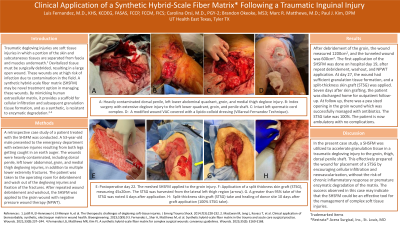Case Series/Study
(CS-058) Application of a Synthetic Hybrid-Scale Fiber Matrix* Following a Traumatic Inguinal Injury

Traumatic degloving injuries are soft tissue injuries in which a portion of the skin and subcutaneous tissues are separated from fascia and muscles underneath.1 Devitalized tissue must be surgically debrided, resulting in a large open wound. These wounds are at high risk of infection due to contamination in the field. A synthetic hybrid-scale fiber matrix (SHSFM) may be novel treatment option in managing these wounds. By mimicking human extracellular matrix, it provides a scaffold for cellular infiltration and subsequent granulation tissue formation, and as a synthetic, is resistant to enzymatic degradation.2,3.4.
Methods:
A retrospective case study of a patient treated with the SHSFM was conducted. A 53-year-old male presented to the emergency department with extensive injuries resulting from both legs getting caught in an earth auger. The wounds were heavily contaminated, including dorsal penile, left lower abdominal, groin, and medial thigh degloving injuries, in addition to multiple lower extremity fractures. The patient was taken to the operating room for debridement and wash out of the degloving injuries and fixation of the fractures. After repeated wound debridement and washout, the SHSFM was applied to the groin wound with negative pressure wound therapy (NPWT).
Results: After debridement of the groin, the wound measured 1200cm2, and the tunneled wound was 600cm2. The first application of the SHSFM was done on hospital day 19, after repeat debridement, washout, and NPWT application. At day 27, the wound had sufficient granulation tissue formation, and a split-thickness skin graft (STSG) was applied. Seven days after skin grafting, the patient was discharged home for outpatient follow-up. At follow up, there was a pea sized opening in the groin wound which was successfully managed with antibiotics. The STSG take was nearly 100%. The patient is now ambulatory with no complications
Discussion:
In the present case study, a SHSFM was utilized to accelerate granulation tissue in a traumatic degloving injury to the groin, thigh, dorsal penile shaft. This effectively prepared the wound for placement of a STSG by encouraging cellular infiltration and neovascularization, without the risk of chronic inflammatory response or premature enzymatic degradation of the matrix. The success observed in this case may indicate that the SHSFM could be an effective tool for the management of complex soft tissue injuries.
Trademarked Items: *Restrata® Acera Surgical, Inc., St. Louis, Missouri
References: 1. Latifi R, El-Hennawy H, El-Menyar A, et al. The therapeutic challenges of degloving soft-tissue injuries. J Emerg Trauma Shock. 2014;7(3):228-232.
2. MacEwan M, Jeng L, Kovacs T, et al. Clinical application of bioresorbable, synthetic, electrospun matrix in wound health. Bioengineering. 2023;10(9):9
3. Fernandez L, Shar A, Matthews M, et al. Synthetic hybrid-scale fiber matrix in the trauma and acute care surgical practice. Wounds. 2021;33(9):237–244. doi:10.25270/wnds/2021.237244
4. Fernandez LG, Matthews MR, Kim PJ. A synthetic hybrid-scale fiber matrix for complex surgical wounds: consensus guidelines. Wounds. 2023;35(5): E160-E168. doi:10.25270/wnds/22067

.png)